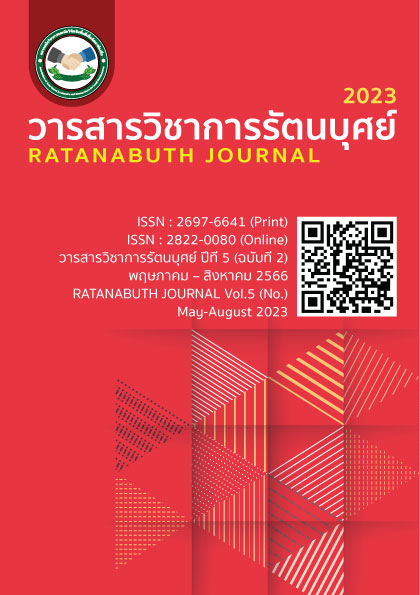Personnel Management Based on Four Sublime States of Mind for Educational Institution Administrators Under Mahasarakham Primary Educational Service Area Office 3 Personnel Management Based on Four Sublime States of Mind for Educational Institution Administrators Under Mahasarakham Primary Educational Service Area Office 3
Main Article Content
Abstract
The objectives of this research were 1) to study the levels of personnel management based on four sublime states of mind for educational institution administrators under Mahasarakham Primary Educational Service Area Office 3 2) to compare the levels of personnel management based on four sublime states of mind for educational institution administrators under Mahasarakham Primary Educational Service Area Office 3 3) to compile the related recommendations as suggested of personnel management based on four sublime states of mind for educational institution administrators under Mahasarakham Primary Educational Service Area Office 3. The sample were administrators and teachers, totally 302 people, and 5 interviewers. The instrument used for data collection was the five-rating scale questionnaire, with content accuracy of 0.80 – 1.00, a confidence level of 0.98 and interview.
The results showed that: 1. The level of the personnel management based on four sublime states of mind for educational institution administrators under Mahasarakham Primary Educational Service Area Office 3 Overall, it was at a highest level, considering from each side in order from the highest to the lowest average. It was found that the highest average was the personnel development, followed by the improving the quality of life, whereas the lowest was the Recruitment and appointment. 2. the results of the level of opinion comparison towards the management of the personnel management based on four sublime states of mind for educational institution administrators under Mahasarakham Primary Educational Service Area Office 3 in mention classified by position level was found statistically significant difference in overall, educational level was found that no difference in overall, and experience level was found that there were differences in each aspect of the manpower planning recruitment, the personnel development, the building morale and honoring and the improving the quality of life. 3. Recommendations for the personnel management based on four sublime states of mind for educational institution administrators under Mahasarakham Primary Educational Service Area Office 3 as suggested by following the principle and the guidelines. By analyzing the needs of the scarce fields before taking into account other fields. Publicing relations, appoint a committee, and following the systematic steps according to the principle and the guidelines. Promoting encourage personnel to increase their knowledge, ability, and experiences from both inside and outside. Emphasising on participation, paying attention, and giving the value in every personnel equally.
Article Details

This work is licensed under a Creative Commons Attribution-NonCommercial-NoDerivatives 4.0 International License.
References
นิภาพร ลาตวงษ์. (2563). องค์ประกอบการบริหารงานบุคลากรตามหลักพรหมวิหาร 4 ของผู้บริหารสถานศึกษา สังกัดสำนักงานส่งเสริมการศึกษานอกระบบและการศึกษาตามอัธยาศัยจังหวัดร้อยเอ็ด. วิทยานิพนธ์ปริญญาครุศาสตรมหาบัณฑิต สาขาการบริหารการศึกษา บัณฑิตวิทยาลัย: มหาวิทยาลัยมหามกุฏราชวิทยาลัย.
พระบัวเงิน สุขธมฺโม (แสงมะณีลาด). (2561). แนวทางการบริหารงานบุคคลตามหลักพรหมวิหารธรรมสาหรับผู้บริหารโรงเรียนมัธยมศึกษา อำเภอละมาม จังหวัดเชกองสาธารณะรัฐประชาธิปไตยประชาชนลาว. วิทยานิพนธ์ปริญญาพุทธศาสตรมหาบัณฑิต สาขาวิชาพุทธบริหารการศึกษา บัณฑิตวิทยาลัย: มหาวิทยาลัยมหามกุฏราชวิทยาลัย.
พระสุวรรณภูมิ ธมฺมรโต (อินทร์รัมย์). (2561). ระบบการบริหารงานบุคคลตามหลักพุทธบริหารการศึกษาของผู้บริหารสถานศึกษาสังกัดสานักงานเขตพื้นที่การศึกษามัธยมศึกษา. ดุษฎีนิพนธ์ปริญญาพุทธศาสตรดุษฎีบัณฑิต สาขาวิชาการบริหารการศึกษา บัณฑิตวิทยาลัย: มหาวิทยาลัยมหาจุฬาลงกรณราชวิทยาลัย.
วายุภักษ์ สิริกาญจนสกุล. (2564). สมรรถนะผู้บริหารที่ส่งผลต่อการบริหารงานบุคคลโรงเรียนสังกัดสำนักงานเขตพื้นที่การศึกษามัธยมศึกษากรุงเทพมหานคร เขต 1. วิทยานิพนธ์ปริญญาครุศาสตร มหาบัณฑิต สาขาการบริหารการศึกษา บัณฑิตวิทยาลัย: มหาวิทยาลัยมหามกุฏราชวิทยาลัย.
สุชาดา วงษ์สกุล. (2564). การบริหารงานบุคคลของผู้บริหารสถานศึกษาที่ส่งผลต่อความผูกพันของครูในสถานศึกษา สังกัดสำนักงานเขตพื้นที่การศึกษามัธยมศึกษา เขต 8. วิทยานิพนธ์ปริญญาครุศาสตรมหาบัณฑิต สาขาการบริหารการศึกษา บัณฑิตวิทยาลัย: มหาวิทยาลัยมหามกุฏราชวิทยาลัย.
สำนักงานเขตพื้นที่การศึกษาประถมศึกษามหาสารคามเขต 3. (ม.ป.ป.). การดำเนินการตามนโยบายการบริหารทรัพยากรบุคคลปีงบประมาณ พ.ศ. 2565. มหาสารคาม: กลุ่มบริหารงานบุคคล กลุ่มพัฒนาครูและบุคลากรทางการศึกษา.
สำนักงานคณะกรรมการการศึกษาขั้นพื้นฐาน. (ม.ป.ป.). คู่มือการบริหารโรงเรียนในโครงการพัฒนาการบริหารรูปแบบนิติบุคคล. กรุงเทพฯ: โรงพิมพ์ชุมนุมสหกรณ์การเกษตรแห่งประเทศไทย.
สำนักงานเลขาธิการสภาการศึกษา กระทรวงศึกษาธิการ. (2560). แผนการศึกษาแห่งชาติ พ.ศ. 2560-2579. กรุงเทพฯ: พริกหวานกราฟฟิค.
เสาวนีย์ เปรมดิลกรัตน์. (2565). หลักพรหมวิหารธรรมของผู้บริหารสถานศึกษาที่ส่งผลต่อการบริหารงานบุคคล สังกัดสำนักงานเขตพื้นที่การศึกษาประถมศึกษากรุงเทพมหานคร. วิทยานิพนธ์ปริญญาครุศาสตรมหาบัณฑิต สาขาการบริหารการศึกษา บัณฑิตวิทยาลัย: มหาวิทยาลัยมหามกุฏราชวิทยาลัย.
Earnest W. D., (1985). Human Resource Strategy - An Integrative Approach. Master’s thesis, Department of Science, Mississippi State University.
Krejcie, R. V. & Morgan, D. W. (1970). Determining sample sizes for research activities. Educational and Psychological Measurement. 30, 607-610.
Kristina T., & Robin T. (2010). Human Resource Management; Motivation among employees in multinational corporations. Master’s thesis, Department of International Business and Economics Program, Kristianstad University.


